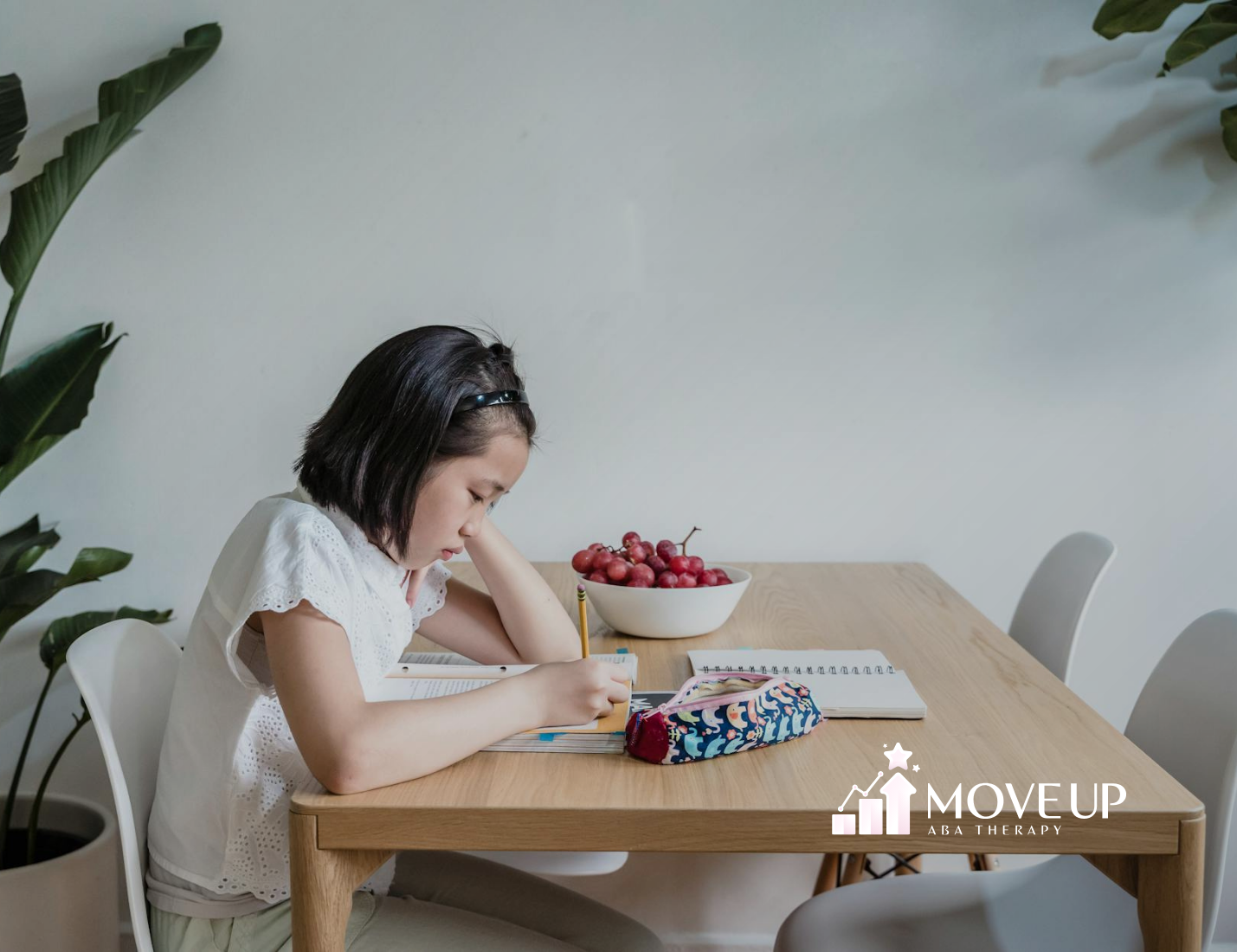Are you a parent in Maryland, navigating the unique challenges of raising a child with autism spectrum disorder (ASD)? Imagine transforming your daily routine into a powerful tool for your child’s growth and development. This article is your roadmap to incorporating effective ABA therapy activities into every moment of your day, from the first morning yawn to the final bedtime story. Discover how simple, everyday actions can become golden opportunities for learning, all while creating a nurturing environment that helps your child thrive.
1. Rise and Shine: Morning Routines with an ABA Twist
Starting the day off right sets the tone for everything that follows. Let’s explore how to make mornings smoother and more productive with ABA-inspired techniques.
1.1 Visual Schedules for a Smooth Start
Create a colorful visual schedule of your child’s morning routine using pictures or simple drawings. These home ABA therapy activities help your child understand what to expect and promotes independence. An example of indepence is when your kids feel comfortable enough to sleep alone.
Try this: Use a magnetic board or a strip of velcro on the wall. Create cards for each morning task (wake up, brush teeth, get dressed, eat breakfast). Let your child move each card to a “done” column as they complete tasks.
Maryland Tip: Include a weather check in your morning routine. Maryland’s varying climate provides a great opportunity to discuss appropriate clothing choices.
Sensory-Friendly Tip: Use soft, muted colors for your visual schedule to avoid sensory overload early in the day.
Success Stories
“Move Up ABA has been a lifeline for our family. Before starting therapy, our son struggled with daily routines and communication. Now, he’s more independent and even initiated a conversation with a classmate for the first time! The progress we’ve seen in just six months is truly remarkable.”
- Emily R., Silver Spring, Accountant
“As a single dad, I was overwhelmed trying to manage my child’s behavior. The Move Up ABA team not only provided amazing support for my little girl but also taught me practical strategies to use at home. Their in-home sessions fit perfectly with our busy schedule. I’m so grateful for their patience and expertise.”
- Michael T., Rockville, Middle School Teacher
“We were hesitant about starting ABA therapy, but Move Up ABA’s approach put us at ease from day one. Our twins have made incredible strides in their social skills and self-regulation. The therapists are like extended family now, and we couldn’t be happier with our decision to work with them.”
- Aisha and James L., Simpson, Police Officers
1.2 Choosing Clothes: A Lesson in Decision Making
Empower your child by letting them make choices about their outfit for the day. This simple activity incorporates several ABA therapy principles for toddlers, including decision-making and following instructions.
Try this: Lay out two weather-appropriate outfits and ask your child to choose. Praise their decision, reinforcing their ability to make choices.
Maryland Tip: Discuss local events or attractions your child might visit that day to help guide appropriate clothing choices.
Key Takeaways for Morning Routines:
Use visual schedules and visual supports to promote independence and reduce anxiety
Incorporate choice-making opportunities to develop decision-making skills
Adapt routines to Maryland’s unique weather and local activities
Use positive reinforcement to encourage desired behaviors
2. Mealtime Magic: Turning Eating into Learning
As we move from morning routines to mealtimes, let’s explore how these everyday moments can become powerful learning opportunities.
2.1 Breakfast Bonanza: Counting and Colors

Transform breakfast into a fun learning experience by incorporating simple ABA therapy activities focused on counting and identifying colors.
Try this: Use colorful cereal or fruit to practice counting and color recognition. “Can you put three strawberries on your plate?” or “Let’s count how many blue berries you have!”
Maryland Tip: Use local produce like Maryland strawberries or blueberries for counting and color recognition activities.
2.2 Lunchtime Learning: Following Multi-Step Instructions
Preparing lunch together can be a great opportunity to work on following multi-step instructions, a key skill in ABA therapy.
Try this: Give your child simple, clear instructions to help make a sandwich. “First, let’s put the cheese on the bread. Next, we’ll add the turkey. Last, we’ll put the top slice of bread on.”
Maryland Tip: Create a “Maryland Lunch” with local favorites, discussing the state’s culinary heritage as you prepare the meal.
Key Takeaways for Mealtimes:
Incorporate counting and color recognition into diet meal preparation and eating
Practice following multi-step instructions during cooking activities
Use natural environment teaching to generalize skills learned in therapy
Break down complex tasks into manageable steps
3. Afternoon Adventures: Structured Play with Purpose
As the day progresses, let’s turn our attention to the afternoon, where structured play can reinforce ABA therapy goals while ensuring your child has fun.
3.1 Backyard Scavenger Hunt: Natural Environment Teaching
Take advantage of Maryland’s diverse landscapes by organizing a backyard scavenger hunt. This activity incorporates natural environment teaching, one of the most effective ABA therapy techniques.
Try this: Create a list of items to find (a red leaf, a smooth stone, a feather). This activity can target specific skills like color recognition, texture identification, and following instructions.
Maryland Tip: Include items specific to Maryland’s ecosystem in your scavenger hunt.
3.2 Puzzle Time: Breaking Down Complex Tasks
Puzzles are excellent for developing problem-solving skills and fine motor control. Use ABA strategies to break down the puzzle-solving process into manageable steps.
Try this: Start with a simple puzzle and gradually increase difficulty. Offer praise for each piece correctly placed, reinforcing positive behaviors.
Maryland Tip: Choose puzzles featuring Maryland landmarks or maps to familiarize your child with their home state.
Key Takeaways for Afternoon Activities:
Use natural environment when teaching children to help your child develop new skills
Break down complex tasks into manageable steps
Incorporate Maryland-specific themes into play activities
Use positive reinforcement to encourage desired behaviors
4. Evening Wind-Down: Calming ABA Activities
As the day draws to a close, it’s time to focus on calming activities that reinforce learning while preparing for a restful night.
4.1 Bedtime Story Bonanza: Enhancing Communication Skills
Story time is a perfect opportunity to work on communication skills, a key focus of ABA therapy.
Try this: While reading, ask your child questions about the story. “What color is the dog?” or “How do you think the character feels?” This encourages active participation and comprehension.
Maryland Tip: Choose books about Maryland history or stories set in the state to build connection with local culture.
4.2 Sensory-Friendly Bath Time

For many children with autism, bath time can be challenging due to sensory sensitivities. Incorporate ABA techniques to make this routine more enjoyable.
Try this: Offer choices in bath toys or soap scents to give your child some control over the experience. Use a visual timer to help your child understand how long bath time will last.
Maryland Tip: Use bath toys shaped like Maryland wildlife to make bath time educational and fun.
Key Takeaways for Evening Routines:
Use bedtime stories to enhance communication skills
Make bath time a sensory-friendly, educational experience
Incorporate Maryland themes into evening activities
Use visual supports to help your child understand routines
5. The Far-Reaching Benefits of ABA Therapy: Beyond Daily Routines
Now that we’ve explored how to incorporate ABA therapy into your daily routine, let’s zoom out and consider the broader impact of Applied Behavior Analysis on your child’s development.
Boosting Independence Across the Board
ABA therapy isn’t just about managing at home – it’s about helping your child thrive everywhere they go. From the classroom to the playground, ABA techniques are all about fostering independence. Teaming up with a Board Certified Behavior Analyst (BCBA) can give you some great ideas for helping your child spread their wings in all sorts of environments.
Take it up a notch: Try practicing those at-home skills in new places, like during your grocery run or at the local park. It’s a great way to help your child apply what they’ve learned to different situations.
Tackling Tricky Behaviors Head-On
One of the coolest things about ABA therapy is how it helps smooth out those bumpy behavioral moments. This evidence-based approach is all about accentuating the positive and gently reshaping challenging behaviors. The goal? Helping your child flourish in all aspects of life.
Pro tip: When you catch your child doing something awesome, shower them with praise or a small reward right away. It’s like giving their good behavior a high-five, making it more likely to happen again!
Making Friends and Understanding Feelings
For many kiddos on the autism spectrum, navigating the social world can feel like trying to solve a complex puzzle. That’s where ABA therapy activities come in handy, helping your child build those crucial social skills, from taking turns to decoding different emotions.
Fun idea: Turn playtime into a mini social skills workshop. Board games are great for practicing turn-taking, and you can use picture cards to play fun “emotion guessing” games. Learning through play – it’s a win-win!
Your Child’s Passions: The Key to Unlocking Potential
One of the superpowers of ABA therapy is how it can be tailored to fit your child’s unique interests and needs. By weaving your child’s favorite things into therapy activities, learning becomes not just effective, but exciting too!
Get creative: Got a dinosaur enthusiast on your hands? Use those prehistoric pals in your activities! Count T-Rexes, sort herbivores from carnivores, or act out dino stories. When learning feels like play, your child’s engagement goes through the roof!
Family: The Secret Ingredient for Success
In the world of ABA therapy, family involvement isn’t just helpful – it’s essential. By actively participating in your child’s therapy journey, you’re like a bridge, helping to reinforce skills and ensure consistency across all areas of your child’s life.
Stay involved: Don’t be shy about asking your child’s ABA therapist for some personalized tips on how you and other family members can keep the learning going at home. They’ll be thrilled to share some strategies tailored just for your family!
Keeping Track of Triumphs: The Power of Data
In ABA therapy, data collection is like having a roadmap of your child’s progress. It might sound a bit technical, but there are simple ways to weave it into your daily life. This information is gold for tracking improvements and tweaking strategies as needed.
Try this: Keep a quick tally of how often your child nails a target behavior on their own throughout the day. It’s a great way to spot trends and celebrate those awesome “level up” moments with your child’s therapist.
When You Need a Helping Hand
While home-based activities are amazing, sometimes you might want a bit of extra support or guidance. That’s where professional ABA therapy services shine. At Move Up ABA, our team of experienced therapists specializes in bringing ABA therapy right to your home, helping your child develop new skills in their most comfortable environment.

Remember, every child’s journey is as unique as they are. What works like magic for one kiddo might not click for another, and that’s totally okay. Don’t hesitate to reach out to ABA professionals for insights on tailoring these strategies to your child’s specific needs. With a healthy dose of patience, consistency, and the right support, you can help your child learn, grow, and truly thrive.
Your Next Steps with Move Up ABA
Incorporating ABA therapy activities into your daily routine is a powerful way to support your child’s development. Remember, consistency is key, and every small step is a victory worth celebrating.
As you embark on this journey, know that you’re not alone. Move Up ABA is here to support Maryland families like yours every step of the way. Our team of experienced ABA therapists and Board Certified Behavior Analysts (BCBAs) can help you develop a personalized plan that works for your family, taking into account the unique aspects of life in Maryland.
Ready to take the next step? Contact Move Up ABA today for a consultation. Let’s work together to create a nurturing, growth-oriented environment where your child can truly thrive. Your Maryland adventure in ABA therapy starts here!
Final Key Takeaways:
Consistency in applying ABA techniques throughout the day is crucial for success
Use positive reinforcement and visual supports to encourage desired behaviors
Create sensory-friendly spaces to support your child’s comfort and learning
Celebrate small victories and progress along the way
Reach out to Move Up ABA for personalized support and guidance from experienced ABA therapists
Together, we can help your child learn new skills, reduce challenging behaviors, and unlock their full potential, one Maryland day at a time.
400 E Pratt St, Floor 8 Baltimore , Maryland 21202, United States
Questions?
Email Us: intake@moveupaba.com
Call Us: (410) 469-1090






